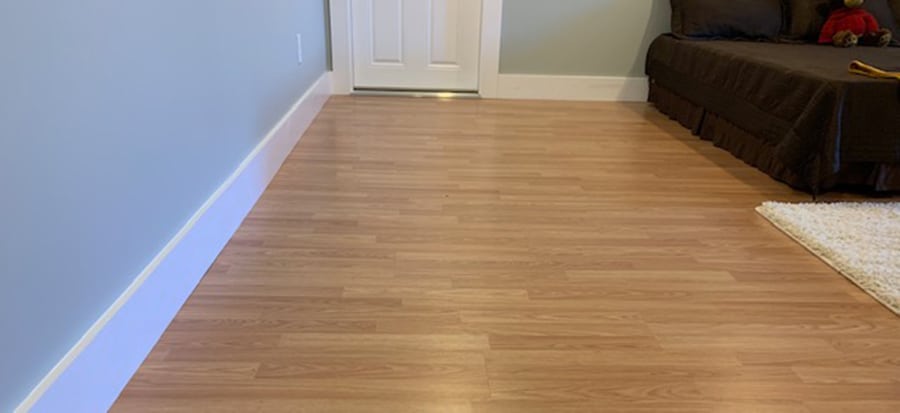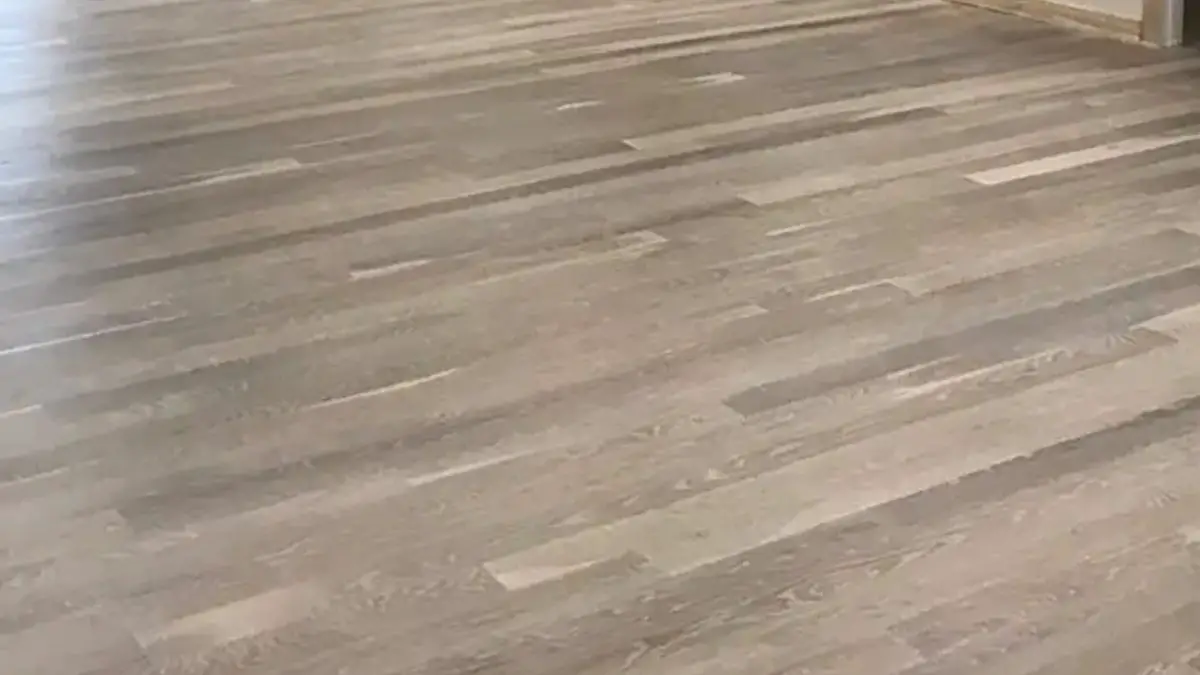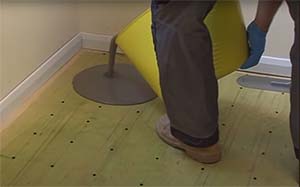
If you have just installed a floating floor in your house or you have made a decision to install one, one of the questions at the back of your mind might be, “should floating floors bounce”?
Floating floors should not bounce unless there are some underlying problems. Many factors like uneven substrate, water, moisture damage, wood floor structure damage, inadequate expansion gaps, and lack of proper acclimatization may cause a bounce in floating floors.
Even though floating floors are not meant to bounce, it is somewhat common. There is a far higher probability of you having a bouncy floor if you have chosen a floating floor rather than a nail or glue it down to the surface of the subfloor.
Floating floor coverings are popular among contractors because it does a good job at hiding minor imperfections or unevenness in the floor substrate.
No need to worry, though, as all of the causes of the bounce in floating floors are addressed in this article, and suggestions are made to rectify or prevent the bounce.
Is It Normal For Floating Floors to Bounce?
If the floating floors are installed correctly, and there isn’t any underlying problem with the subfloor, they are not supposed to bounce.
However, the problem is not uncommon; people with newly laid floating floors in their house often feel soft and bouncy spots in their flooring.
Although you need to ensure a few things to make sure it is nothing too serious of a problem:
- Check if the floating floor feels bouncy across the entire floor or just a specific area.
- If it is in a specific area, then the subfloor likely did not have a leveling compound applied before installation, a commonly skipped prep issue to reduce installation costs.
- If it is across the entire floor, it’s more likely that you feel the new moisture barrier or pad laid underneath the floating floor, which is supposed to feel a bit soft. The bounce will dampen with time and the application of weight over it (Furniture).
- Check if there’s a popping sound while walking over them.
- In this case, the installer did not level the subfloor before the installation. Uneven subfloor often tends to make a crackling sound and maybe why the floor feels bouncy.
- Check if the bouncy floor is also saggy or too soft.
- This one can be a bit worrying as the cause for this might be a bigger problem related to subfloor damage due to excessive moisture, leakage, spillage, or flooding.
- If not resolved within time, it can lead to complete damage to both the subfloor and the floating floor.
If you feel like the bounce isn’t due to any of the above problems, you can contact your contractor to look at it, and he will be able to help you better.
Also, if the bounce is minimal, there likely is nothing much to worry about, as this will diminish with time.
What Causes The Bounce In Floating Floors?
Several factors can cause the ” bounce” in floating floorboards. Here, in this section of the article, some of the factors that might result in the bounce are stated and briefly discussed.
1. Issues Related To Uneven Subfloor
A floating floorboard usually is straight (unless it is warped), and if the subfloor is not level, there will be a void between the plank and the floor.
As soon as someone walks over it or some weights have been put upon it, the plank will start moving down due to the gap until it touches the subfloor. Thus, this up and down motion creates a bouncy feeling while walking over it.
Another issue that can be tied to the subfloor, which can result in having a bouncy floating floor, is leaving behind debris during the installation of your subfloor.
How can you resolve an issue with the uneven subfloor?
- You have to pull up the affected planks, clear all the debris on the subfloor, make it level, and then lay the planks again.
- Please ensure that proper leveling of the subfloor is done before the installation.
Please refer to this table for flatness tolerance.
| Type of subfloor | Flatness tolerance in a 6 foot radius | Flatness tolerance in a 10 foot radius |
| Concrete Subfloor | 1/8″ | 3/16″ |
| Wooden Subfloor | 1/8″ | 3/16″ |
2. Issues Related To Water Damage
Leakages from the roof, faulty pipes, and the likes might result in an excessive inlet of water. This excessive inflow of water might damage the subfloor, which might result in bouncy and saggy flooring.
Materials like plywood, which usually makes up the subfloor component, cannot withstand being over flooded with water.
Once flooded, most of the links between the subfloor components disintegrate, which might damage the whole wooden floor.
How to resolve it?
- If the bounce in your floor is related to flooding or excessive moisture, try checking your plumbing for leaks or other water intrusion.
- Also, check your roof for leakages.
- Try to wipe all sorts of spillage as soon as possible.
- If the issue is a high humidity level, use a dehumidifier to regulate moisture in the air.
- Check below the planks; if there is a dark discoloration, it signifies mold and mildew. Check out this article to get rid of molds.
If this DIY idea of fixing the problem doesn’t work, kindly reach out to a professional contractor.
3. Termite Damage To The Floor Joists And Trusses
If you have ruled out water and moisture damage for a soft spot you have found, then one of the primary reasons for floor joists and trusses’ damage is an attack from termites since their favorite object to snack on is wood.
Although they are relatively small insects, the damages caused by termites can be quite extensive. They can get inside of your wooden supports and eat it out, destroying the joists and trusses.
How to get rid of termites?
- Use oil treatment in the affected areas, orange and neem oil is one the best options.
- Use Borax Powder in the affected areas. Boric acid is a non-toxic treatment to handle termites.
- Expose the affected planks to sunlight if possible.
4. Issues Related To Acclimatization
Wood is expected to expand and contract with the change in temperature and humidity. Therefore, during the installation of a floating floor, an essential factor is ensuring that it is appropriately acclimatized to your home’s temperature and humidity.
Failure to do this might result in an unexpected expansion under extreme conditions of moisture and temperature. This can result in a bouncy floor.
How to eliminate bounce due to acclimatization?
- If there is a scope for creating proper space for expanded planks by trimming the expansion gaps, it could save a lot of time.
- Use a humidifier and dehumidifier to control the moisture and temperature to reduce the acclimatization effect.
- If the above solution doesn’t work out, you have to pull out all the planks and reinstall them. This time, let the floorboard get acclimated to the environment of your house for 1-2 weeks.
5. Inadequate Expansion Gaps
As discussed earlier, the floating floors need their own space for expansion and contraction with changes in temperature and humidity.
If proper expansion gaps are not left across the wall endings or door jambs, then planks can only move upward and downward, thus creating a bouncy effect for the floor.
How to resolve the expansion gap issue?
- Leave a standard expansion gap of around 1/2″ while installing the planks.
- Use accurate spacers of around 1/2″ to leave proper expansion gaps.
- Trim down the planks towards the wall endings and door jambs using a chisel or handsaw to make the required expansion gap.
Steps Involved In Fixing Brouncy Floating Floors
If there is a bounce in your floating floor, there are a few simple steps that are recommended for you to ensure you eliminate the bounce with ease and without mistake.
1. Try to identify the source of the problem. The possible causes and their solution is discussed above.
2. Check the subfloors for imperfections like noise, bounce, lifting of the floor, and if there are any, try to address them as soon as possible.
3. Remove the floorboards that are damaged. For loose subfloor that claps against the wood framing, secure the subfloor to the framing with wood screws.
4. Replace the damaged subfloor boards with new ones.
After doing this, the bounce in your floor should be eliminated, and your floorboards should feel as new as ever.
If you stick with these guidelines, eliminating the bounce in your floating floor should prove to be a relatively easy task.
Can The Bounce In Floating Floors Be Prevented?
It is not always easy to resolve issues with your floating floors, but it may be unavoidable. The bounce in floating floors can be prevented following a few simple tips.
- Make sure you use the best quality underlayment and laminate flooring.
- Before installing the flooring, ensure that the subfloor is as flat and even as possible. An uneven subfloor practically sets the floating floor up for a bounce.
- Ensure that your floating floor installation follows manufacturer specifications. Allow laminate planks 72 hours to acclimate before installation.
- Make sure that enough expansion gap left for the expansion and contraction of the floating floor.
- Maintain a 45% to 55% humidity level in your home. Avoid swings in temperature as well to minimize expansion and contraction of the flooring.
- If your home is a crawl space, ensure there are no unaddressed moisture problems. Install a vapor barrier over the ground in the crawl space to control moisture. For severe moisture problems, your crawl space may need encapsulation.
- Check your plumbing for leaks at least once per year.
- Try to avoid water spillage as much as you can.
- Try to avoid wet mopping as much as possible. Use a dry mop daily and a damp mop weekly. Avoid using a steam cleaner on laminate floors.
You have reached the end of this article. I hope this article helped you understand the issues related to bouncy floating floors and how you can overcome them easily.







